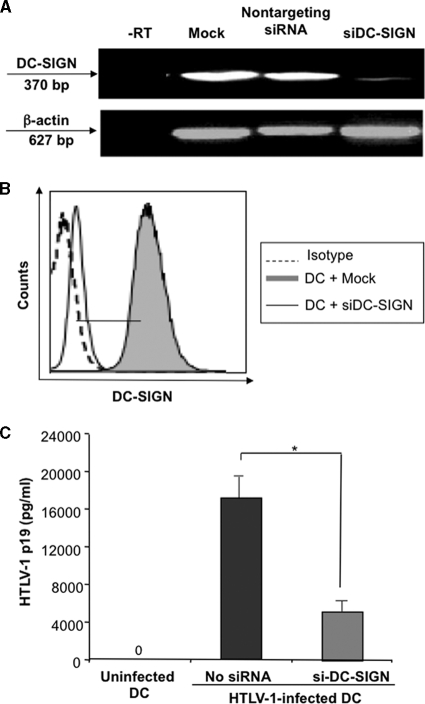FIG. 7.
Silencing of DC-SIGN expression inhibits HTLV-1 infection of DCs. DC-SIGN was silenced by transfecting DCs with siRNA targeted against DC-SIGN. Nontargeting siRNA was used as a negative control, whereas DCs only with transfection reagent were considered the mock control. (A) To confirm gene silencing, DC-SIGN mRNA levels were determined in GeneSilencer (mock)-transfected cells and cells transfected with nontargeting siRNA or siDC-SIGN. Real-time PCR analysis using DC-SIGN-specific primers to amplify a 370-bp product spanning the silenced region confirmed DC-SIGN silencing in transfected cells. β-Actin was used as an internal control. (B) The effect of silencing also was monitored by the cell surface expression of DC-SIGN. A total of 50,000 events collected for each sample were gated to include the Lin-1−/DC-SIGN+ population. The dotted-line histogram represents the isotype control, while filled and solid-line histograms represent DC-SIGN expression on the mock-transfected and siDC-SIGN-transfected DCs. (C) DCs silenced for DC-SIGN were infected with cell-free HTLV-1 for 3 days, washed, and cultured in fresh medium for an additional 3 days. The level of HTLV-1 gag protein (p19) in the supernatant of infected DCs was determined by ELISA. Supernatant from uninfected DCs was used as a negative control. A standard curve generated for HTLV-1 p19 antigen was used to determine productive infection in each sample. p19 levels (in picograms/milliliter) are represented as the means ± standard deviations from triplicate samples. The experiment was repeated twice. An asterisk denotes a statistically significant decrease in HTLV-1 p19 levels in siDC-SIGN-transfected DCs compared to that of mock-transfected DCs (P ≤ 0.05).

